We met the British Gas Smart Homes Team to discuss energy meters, home security, remote heading control and charging for electric vehicles. Here’s the transcript of our focus on British Gas Smart Homes, from Show 76.
Listen to FrequencyCast Show 76 – British Gas Smart Homes (31 mins)
|
Behind The Scenes at British Gas:
In May 2012, we were invited to take a peek behind the scenes at British Gas to find out more about their Smart Homes solutions. Here’s a transcript of our feature. You’ll find longer versions of the interviews here: British Gas Smart Homes.
Pete:
Now, you may remember, Kelly helped us out in our Christmas gadget shopping show last year, and we went out and about to a shopping centre, if you remember, looking at gadgets, and I think you fell in love with that Marmite chocolate?
Kelly:
I can’t think of anything worse than Marmite chocolate. I’ll never, ever forgive you for that – that was not a Christmas treat!
Pete:
Now, don’t worry, Carl fans – he will be here later in the show, but Kelly’s here with me to talk about a very exciting topic, which is:
Kelly:
Well, from looking at these notes, gas bills.
Pete:
You don’t sound very excited about that.
Kelly:
Who’s excited about gas bills?
Pete:
 Fair enough, but bear with me, because it does get more exciting. As you may remember, earlier this year we spoke to the guys at British Gas about these new Smart Meters that we’ll all be getting soon
Fair enough, but bear with me, because it does get more exciting. As you may remember, earlier this year we spoke to the guys at British Gas about these new Smart Meters that we’ll all be getting soon
Kelly:
Ah yeah – you said something about that, and they were so impressed, they actually asked you to go and meet them, didn’t they, at their UK HQ?
Pete:
They did indeed. We had a good look round the various smart homes buildings in Middlesex, including a sneak peek into their rather flashy R & D lab, although sadly no mics or camera allowed. Now,we spoke about Smart Meters in Show 74, and after that piece, we had a few questions from listeners about how these meters are going to be installed between now and the end of 2019. Here’s British Gas’s Tim Jones.
Tim:
That is something that the government has mandated, and they’ve come out to the energy companies, and they’ve said, by the end of 2019, all our meters in the country, that’s gas and electricity, need to be smart.
Pete:
Now, we caught up with your colleague, Paul Grosvenor, when we were at the Ideal Home Show earlier this year, and he gave us a fairly good overview of how these meters are going to work. We did have some listener questions that came in, and one of them was, how does this actually get fitted? So at the moment, taking a look at my home, I have a gas meter in the garage, and under the stairs I have a lekky meter. I’m going to have, is it right – one meter, two meters? – how does it work?
Tim:
Three meters more. No, you’re going to get two meters, so it’s one smart gas meter, and one smart electricity meter, and then there’s also a little box, probably the size of maybe two cigarette packets or so, and that’s separate. We call that a communications hub, and what that does is, it takes the meter reads from the electricity meter and from the gas meter, puts them together, and then sends them over to us.
Pete:
OK, and if I’ve got this right, that means an end to meter reading. Once a day it sends your combined data over the air presumably to some massive computer at British Gas that calculates our bills?
Tim:
Definitely, and it will be a massive computer. Every night we will get meter reads for that day, so just like as though a meter reader is turning up every day and taking down that number, but it will also give us, and this is if you let us, it has the ability to give us half-an-hour reads, so that’s seeing what your consumption is during the day, so we can see if you use a lot during the day, in the evenings, at night. But what we’re going to use with this, we’re going to do some pretty clever data analytics with it, and we can help show you, if you’ve got what the Americans like to call vampire drain, which is where you’ve got a baseload going on at night, so all those red lights on your TVs and your Xboxes, it’s called vampire, because it usually happens at night. If that’s quite high, we can say, look guys – you seem to be using a lot of energy at night that you probably don’t need to be doing, and then turn around and give you guys some personalised advice.
Pete:
There’s a unit that gets installed to the home, that’s a little wireless device that gives you real time information about both your gas and electricity – is that right?
Tim:
Yes, we’re calling those our smart energy monitors, and that means that British Gas get all your energy reads, as I said, every night coming up over the mobile network, but internally you get a monitor. Again it speaks wirelessly, so you can sit it in the kitchen, you can sit it in your living room, and what that will do is show exactly what you’re using at that time, so it gives you a kind of an energy speedo, almost. It’s to help put into context what having all your lights on is like, or all your appliances on at the same time.
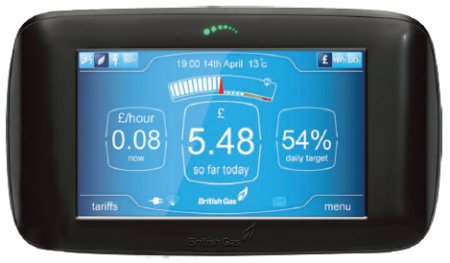
Pete:
Now, we’ve tried some of these on our shows in the past, these little electrical devices that clamp over your incoming main supply. I’m assuming this is a little bit more accurate, and gives you some more detailed information?
Tim:
Exactly, the principle is the same. Where the smart energy monitor is different is, we give you gas as well as electricity. You can’t really clamp on your gas. Also, these are intimately tied to our billing system, so those ones that clamp on are giving you a rough approximation. This one is actually what is going through your meter, so it’s the same numbers that are on your meter are the same numbers that are going to be on your in-home display.
Pete:
And am I right that the unit can also receive messages from British Gas? – so if my tariff changes, or there’s something your computer wants to tell me about, I can receive a message on this device?
Tim:
Yes, I think it’s a good way of being able to communicate with our customers, and giving them vital information. If at any time the gas or electricity network goes down, we’ll be able to send messages there. We’ll be able to send messages – yes, you might have your electricity turned off for a couple of hours for maintenance work, but it’ll be going back on again at four o’clock this afternoon, and yes, if there’s tariff changes, we can send those to people too.
Pete:
So, by 2020, I’ll be getting two new meters installed at my home. How much is that going to cost me as a consumer, to get these new high-tech meters?
Tim:
As a consumer, it will cost you nothing.
Pete:
Oh, that sounds good. There must be a catch though – presumably, is it the government subsidising these meters?
Tim:
No, it’s the energy companies who are paying for the meters, but our traditional meters have a lifespan anyway somewhere between 10 to 15 years, and they need to be replaced, so as those ones get too old, instead of putting another traditional meter on the wall, we’ll replace it with a smart meter.
BONUS: Longer version of our Smart Meters interview with Tim Jones from British Gas (8 mins)
|
Pete:
As well as smart meters, British Gas had a couple of other offerings for us. We spoke to Elvin Nagamootoo about these products – a home monitoring package, as well as a collection of white boxes to control our central heating.
Elvin:
Remote Heating Control is the product that you’re referring to, the three white boxes. The first one is a hub, which connects to your broadband router.
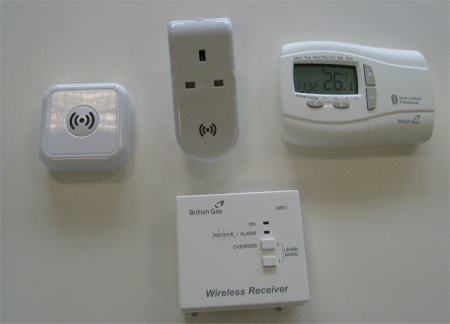
Remote Heating Control. More: Remote Heating Control Installation
Pete:
OK, so you plug this into your router, and presumably something talks to it and does something clever?
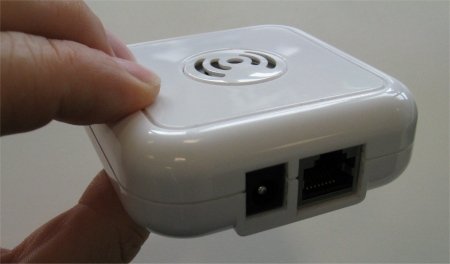
Elvin:
Pretty much in a nutshell exactly what you said, so there is a web-based interface that allows you to control your heating remotely, either through the internet, through an app, so IOS or Android, and also text messaging as well.
Pete:
So we have the hub, it plugs into your internet connection, and then presumably you have this thermostat on the wall. I’m assuming that replaces our existing thermostat?
Elvin:
That’s completely correct. This will sit on the wall. It measures temperature in that space, and that communicates to the hub. It also communicates to the other device that you mentioned, which is a receiver.
Pete:
I’m assuming the wireless receiver, if I’ve got this right, this is the bit that goes to the boiler that controls the temperature that your boiler’s running, and the timing of the boiler – is that right?
Elvin:
The wireless receiver is actually the only piece that’s wired in, and it’s wired either directly to a combination boiler, or to the motorised valves that traditionally sit potentially in an airing cupboard.
Pete:
OK, now, does this mean I need to get a new boiler?
Elvin:
No, you’re more than welcome to get a new boiler if you require it and it can be fitted at the same time. Alternatively there will be the option to have it retro-fitted, so it will work with a full range of boilers. The wireless receiver is just a relay that switches the boiler back and on, so it’s just an on/off signal.
Pete:
Presumably it has to be professionally installed and set up for safety reasons, but this would then mean that you can wirelessly control your heating for the home outside of the house, so over the internet, from your smartphone. What sort of entry-level price would we be talking about, to replace an existing system and get online with this?
Elvin:
The maximum selling price will be £229.
Pete:
And what about the ongoing subscription costs?
Elvin:
There are no subscription costs for this product, and the app is also free in both Google Play, and also the app store.
Pete:
I’m impressed. I like things that are subscription-free, that’s brilliant. OK, if we can now move onto your other range of products that we have here.
Elvin:
OK, so you’re looking at Safe and Secure. It consists of a hub; it has GPRS back up and it has battery back up as well.
Pete:
If I’ve got this right, we have two little boxes here which are presumably PIR sensors, so they’re your motion detectors.
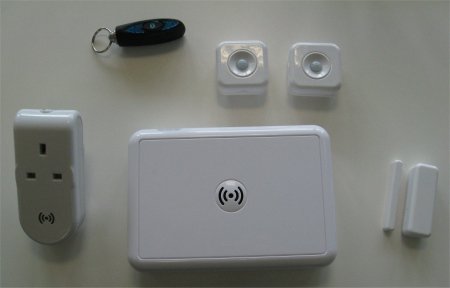
Safe & Secure Kit
Elvin:
Yes, exactly right – they work in the same way as a standard traditional motion sensor does.
Pete:
OK, and we’ve also got a door device here. I’m assuming one half of that sticks to the wall next to your door, the other bit on the door, and when the door’s opened, the connection’s broken.
Elvin:
Yes, that’s correct again. It works using a magnet to detect the fact that the door has been opened, and the product will then alert you.
Pete:
And we’ve got a mains socket. Now, a couple of uses for this: one, you could plug it into a lamp, so you could turn on your lamp automatically to make it look like the house is open, or presumably if a burglar breaks in, you can get the kettle on for them?
Elvin:
Yeah, exactly that. It gives you the ability to track the energy of any device that’s plugged into it.
Pete:
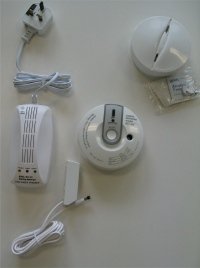 Excellent, and some other gadgets here we’ve got as well – we’ve got a natural gas detector, a bit of a heavy beast here, and we’ve got a carbon monoxide alarm, and is that a standard smoke alarm?
Excellent, and some other gadgets here we’ve got as well – we’ve got a natural gas detector, a bit of a heavy beast here, and we’ve got a carbon monoxide alarm, and is that a standard smoke alarm?
Elvin:
That’s correct, yes – it’s a smoke detector. Again, the main key difference is the fact that, I suppose, if you’re not in the actual property, the smoke alarm’s great when you’re there, but if you’re not, you don’t know about it. This product allows you, gives you that ability to know and actually maybe do something about that to mitigate some of the damage.
Pete:
And this one here, this is an unusual one – I don’t recognise this one.
Elvin:
That’s a water leak detector, so you can position that in a place where there may be a potential of flooding.
Pete:
And the other thing we’ve got here is a fairly chunky key ring. Now, I’ve looked at home alarm systems before. Some of them have used the RFID technology, where you have to place a tag in front of a sensor. I’m assuming … this is a bit bigger, it’s obviously battery-powered, and presumably you don’t need to touch this against something. This is a wireless key fob, is that right?
Elvin:
Yeah, that’s correct – it works off Zigbee. It has a battery inside, and what that allows you to do is arm and disarm the system. It also gives you some presence functionality as well, so on your dashboard you’ll have a widget that’ll show you how many people are at home at that point in time.
Pete:
And looking at the basic entry-level system, can you just explain to me what the basic package would give you, and what sort of price we’d be looking at for that?
Elvin:
For Safe and Secure, you’ll have a hub, you’ll have two motion sensors, door and window contacts. You also get a decoy bellbox as well, which would go on the external of the property.
Pete:
OK, and what sort of price would we be looking at for the entry level kit?
Elvin:
So it’s £199, and that’d be for a self-installation, so it’s easy enough to actually set this stuff up yourself. As you’ve said, there’s no wires. It uses taser strips, so stickies to go onto the wall.
Pete:
Superb, and let’s say something does go wrong, someone breaks into your house – what happens? How do you know about it?
Elvin:
So the system is configurable, so you can set who the people are that you want to notify. They will either receive a text message or email, depending on what are the preferences that you set. There’s also, talking about sensors, there are pet-friendly versions of the sensor as well. They have a tolerance up to 18 kilograms, and they work on a mass basis.
Pete:
Elvin from British Gas there, reassuring you Kelly that your cat Murphy won’t be setting off those alarms.
BONUS: Longer version of our interview with Elvin Nagamootoo from British Gas (12 mins)
|
Kelly:
It’s not all about gas bills and energy meters, though. British Gas are hot on energy-efficient vehicles.
Pete:
Yes they are, and their vision of the home of the future involves charging points for electric cars.
Kelly:
And you got to test drive an energy-efficient car?
Pete:
I did, yes.
Kelly:
So jealous!
Pete:
I am inside the …
Kelly:
Nissan Leaf.
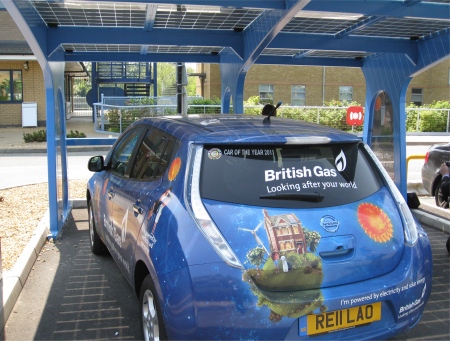
Nissan Leaf at the British Gas Solar Charging Station
Pete:
Excellent, and I’m talking to Katie from British Gas. Which department are you in at the very large company that is British Gas?
Katie:
I’m in British Gas Smart Homes.
Pete:
You’re going to take me for a little drive in this lovely electric vehicle. We’re currently stationary, and this is the impressive bit, is actually starting the engine, for want of a better word. Katie, could you fire it up for me?
Katie:
OK.
Pete:
OK, so that’s it, isn’t it?
Katie:
Absolutely, so complete silence – no engine noise in the cabin at all, inside or outside.
Pete:
And of course this is fully automatic, so there’s no gearbox or anything like that – it’s just, press the button and go.
Katie:
Yep, absolutely – it’s just as you would with a normal automatic, so park, reverse, drive, neutral – very simple.
Pete:
Brilliant, OK – let’s go for a drive. Woah, so we’re off and running. That is unusual – it feels a bit like when you start your car without the engine running, and just lose the handbrake – you’re moving forward with absolutely no engine noise. That is a very unusual sensation. There is a little bit of noise, of course – that’s the tyres on the road, that’s just normal road noise rather than engine noise, but it is very quite. It’s like a recording studio in here. Katie, how is it to drive?
Katie:
Very smooth, very responsive, so very small movements on the accelerator and brake, and really fun to drive as well.
Pete:
And we’ve got some nice tech here – I can see to the right of your dash, there’s a display that says, 86 miles, and that presumably is 86 miles left before I need to charge?
Katie:
Yes, it is, so very much like your fuel indicator. In 86 miles, I’ll have run out of battery, so plenty of life left to go, and it’s very clear as to when it’s getting to that point as well, and when I need to go back and charge.
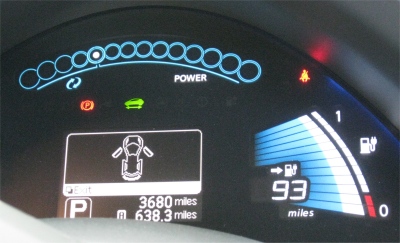
Nissan Leaf – Power Remaining Indicator
Pete:
OK, I’m just going to let you concentrate on your driving while we do this. There’s also a very nice display that looks like a … ooh, a little jump there – the brakes are a little bit nippy on this, aren’t they? They’re a little bit on the sharp side, I have to say.
Katie:
I know, it’s terrible! In any electric car I’ve driven, they’ve been very similar, so when I drove the Mercedes Vito E-CELL a few months ago, again very similar, and that’s a huge van. Very, very small movements on the brake, but once you’ve got the hang of it, then it comes very naturally.
Pete:
It actually feels like the opposite of a car, so when you start a car, nothing happens until you put your foot on the accelerator, and then there’s power. This actually feels like the power’s always there, and effectively you’re holding it back. But yeah, a very nice, smooth ride – amazingly quiet. We’re doing, what speed are we doing now? – about 20 miles an hour down a fairly residential street, so we’re not flooring it, but presumably this can get up to a decent speed?
Katie:
Yeah absolutely, and it’s much quicker off the lights than a normal car, so it’s quite pleasing to take some of the faster-looking cars on the road away at the lights. But absolutely, 70 miles an hour, whatever you want to do on main motorway driving – it’s not a problem.
Pete:
And looking at the display in front of me, we’ve got a telly in the central dashboard there. That’s obviously your radio and your satnav. You were saying there was an interesting feature about the satnav, telling you where to charge – is that correct?
Katie:
Yes, so for a lot of people who are concerned about being left without enough charge to get home, the Nissan Leaf comes with a map which shows available charging points near to the vehicle, so if you are panicked, then you can pull over and just top up, so that you can get home or get to where you need to be.
Pete:
And if I’ve got this right, the plan is that most people that go for electric cars will have a home docking station at some point. There’ll be potentially work docking stations as well, and of course the public ones – is that about right?
Katie:
Yes, it is, so we think about two-thirds of people will charge at home, overnight mostly, with the rest being used at work or on street, really that is just for convenience.
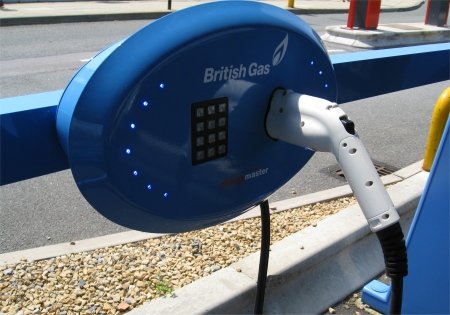
British Gas EV Charging Point
Pete:
So we’re in the Nissan Leaf. This has a nominal range on a charge of roughly how many miles?
Katie:
So it’s about 100 miles.
Pete:
And how long is an average charge, to charge from flat, for the Nissan?
Katie:
It depends what you’re charging it with. If you’re charging it with just a circuit and sockets at home, a three-pin socket, then it’s about ten hours from flat to full. If you’re charging off something a bit faster, so say a charging point, then you’re looking at a third off that, so about six hours.
Pete:
OK Katie, thank you very much. One final question for you: the public stations, you were telling me earlier the deal for using a public charge point. How much would it cost, if I were to need a public charge point?
Katie:
So the government initiative for plugged in places is a really great deal at the moment. For £10 per year, you are able to charge up at any station within the network that you’ve chosen, so let’s take Source London, for example. You can pay £10, you’ll then be sent an RFID card or a swipe card, which means you can access any of the units in the Source London area, and it’s completely free. You don’t have to pay for any of the electricity that you use, and often there are also some good parking arrangements as well next to those units, so it is a great option, if you’re out and about.
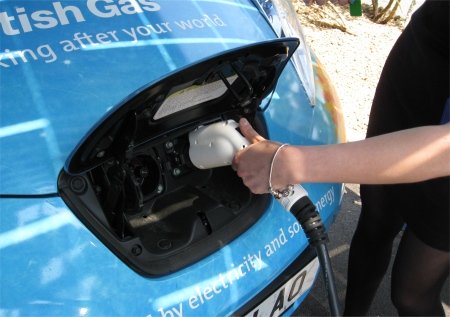
Charging the Nissan Leaf
Pete:
Superb, wonderful – Katie, thank you very much for your time, and for the lovely drive. It’s the quietest drive I’ve ever had.
Katie:
You’re welcome – thank you.
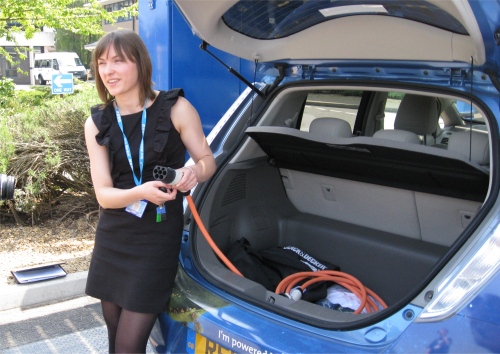
Katie, demonstrating the charging cable
Kelly:
That sounds like you had a lot of fun. When do I get a go?
Pete:
Aah – are you jealous?
Kelly:
Very.
Pete:
Ah, well you’ll have to console yourself by looking at the website, where you can find some photos of the drive. You’ll also find some longer versions of the interviews with British Gas on our site at www.frequencycast.co.uk/britishgas.html. Thanks to Katie for the lovely smooth drive, and to British Gas for opening their doors to FrequencyCast.
Transcript continues Nextorch MyTorch Transcript
BONUS: Longer version of our Nissan Leaf Test Drive, with Katie Alloway from British Gas (10 mins)
|